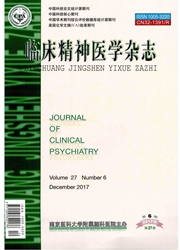

 中文摘要:
中文摘要:
目的:比较度洛西汀单用或联合重复经颅磁刺激( rTMS)治疗广泛性焦虑障碍( GAD)的临床疗效和安全性。方法:113例GAD患者随机分为研究组( rTMS联合度洛西汀治疗)56例和对照组(单用度洛西汀治疗)57例,疗程4周。采用汉密尔顿焦虑量表( HAMA)、临床疗效总评量表( CGI)、治疗中出现的症状量表( TESS)分别在治疗前后评估疗效和不良反应。结果:研究组显效率76.7%,对照组显效率71.9%(F=1.441,P〉0.05)。两组HAMA评分时间主效应存在统计学意义(F=163.12, P〈0.05),组间主效应(F=1.44)及交互效应(F=1.62)均无统计学意义(P〉0.05)。两组CGI评分组间主效应(F =49.29,P 〈0.05)、时间主效应(F =1043.00,P 〈0.001)以及交互效应(F =49.29, P〈0.05)均有统计学意义。两组TESS评分差异有统计学意义(t=4.983,P〈0.05)。结论:度洛西汀单用或联合rTMS治疗GAD疗效相当,但后者起效更快,不良反应更小。
 英文摘要:
英文摘要:
Objective:To observe the clinical efficacy and safety of repetitive transcranial magnetic stimu-lation( rTMS)combined with duloxetine in the treatment of generalized anxiety disorder( GAD)patients. Method:One hundred and thirteen patients diagnosed as GAD were randomly divided into experimental group ( rTMS plus duloxetine,57 patients)and control group( only duloxetine treatment,56 patients). At the begin-ning of the experiment and at the end of first,second,and fourth week of the trail,the symptom severity,clinical effect and side effects were evaluated by Hamilton anxiety scale( HAMA),the clinical global impression scale (CGI)and the treatment emergent symptom scale(TESS)respectively. Resuits:The marked effective rate (76. 7%) of experimental group was not significantly different from that ( 71. 9%) of control group (F=1. 441,P〉0. 05). On HAMA,time main effect(F=163. 12,P〈0. 05)was statistically significant,while group main effect( F = 1. 44 ) and interaction effect( F = 1. 62 ) were not statistically significant( all P〉0. 05). There were significant group main effect(F=49. 29,P〈0. 05),time main effect(F=1043. 00, P〈0. 001)and interaction effect(F=49. 29,P〈0. 05)on CGI. The two groups showed significant differences on TESS(t=4. 983,P〈0. 05). Conciusion:Both two-treatment paradigms have similar clinical outcome. But patients from rTMS plus duloxetine group showed more quickly clinical remission,rare side effect and a bet-ter treatment adherence.
 同期刊论文项目
同期刊论文项目
 同项目期刊论文
同项目期刊论文
 The effect of citalopram on chronic stress-induced depressive-like behavior in rats through GSK3 bet
The effect of citalopram on chronic stress-induced depressive-like behavior in rats through GSK3 bet Quetiapine add-on therapy improves the depressive behaviors and hippocampal neurogenesis in fluoxeti
Quetiapine add-on therapy improves the depressive behaviors and hippocampal neurogenesis in fluoxeti Gastrodin Ameliorates Anxiety-Like Behaviors and Inhibits IL-1β Level and p38 MAPK Phosphorylation o
Gastrodin Ameliorates Anxiety-Like Behaviors and Inhibits IL-1β Level and p38 MAPK Phosphorylation o Antipsychotics promote the differentiation of oligodendrocyte progenitor cells by regulating oligode
Antipsychotics promote the differentiation of oligodendrocyte progenitor cells by regulating oligode Citalopram alleviates chronic stress induced depression-like behaviors in rats by activating GSK3 be
Citalopram alleviates chronic stress induced depression-like behaviors in rats by activating GSK3 be Electroconvulsive therapy improves antipsychotic and somnographic responses in adolescents with firs
Electroconvulsive therapy improves antipsychotic and somnographic responses in adolescents with firs Sensorimotor gating and memory deficits in an APP/PS1 double transgenic mouse model of Alzheimer&apo
Sensorimotor gating and memory deficits in an APP/PS1 double transgenic mouse model of Alzheimer&apo Anti-depressive mechanism of repetitive transcranial magnetic stimulation in rat: The role of the en
Anti-depressive mechanism of repetitive transcranial magnetic stimulation in rat: The role of the en Quetiapine and repetitive transcranial magnetic stimulation ameliorate depression-like behaviors and
Quetiapine and repetitive transcranial magnetic stimulation ameliorate depression-like behaviors and Gastrodin Alleviates Cerebral Ischemic Damage in Mice by Improving Anti-oxidant and Anti-inflammatio
Gastrodin Alleviates Cerebral Ischemic Damage in Mice by Improving Anti-oxidant and Anti-inflammatio Rosmarinic acid ameliorates PTSD-like symptoms in a rat model and promotes cell proliferation in the
Rosmarinic acid ameliorates PTSD-like symptoms in a rat model and promotes cell proliferation in the Atypical Antipsychotics Do Not Reverse Prepulse Inhibition Deficits in Acutely Psychotic Schizophren
Atypical Antipsychotics Do Not Reverse Prepulse Inhibition Deficits in Acutely Psychotic Schizophren Gastrodin ameliorates anxiety-like behaviors and inhibits IL-1beta level and p38 MAPK phosphorylatio
Gastrodin ameliorates anxiety-like behaviors and inhibits IL-1beta level and p38 MAPK phosphorylatio 期刊信息
期刊信息
